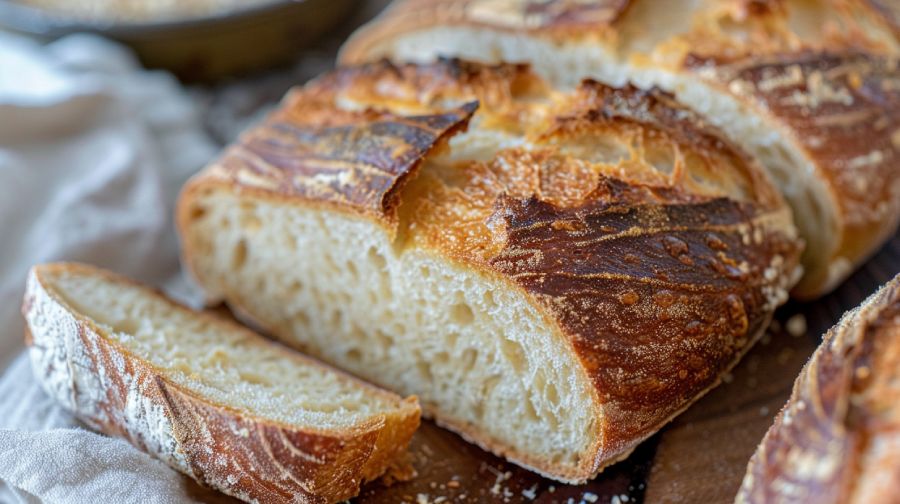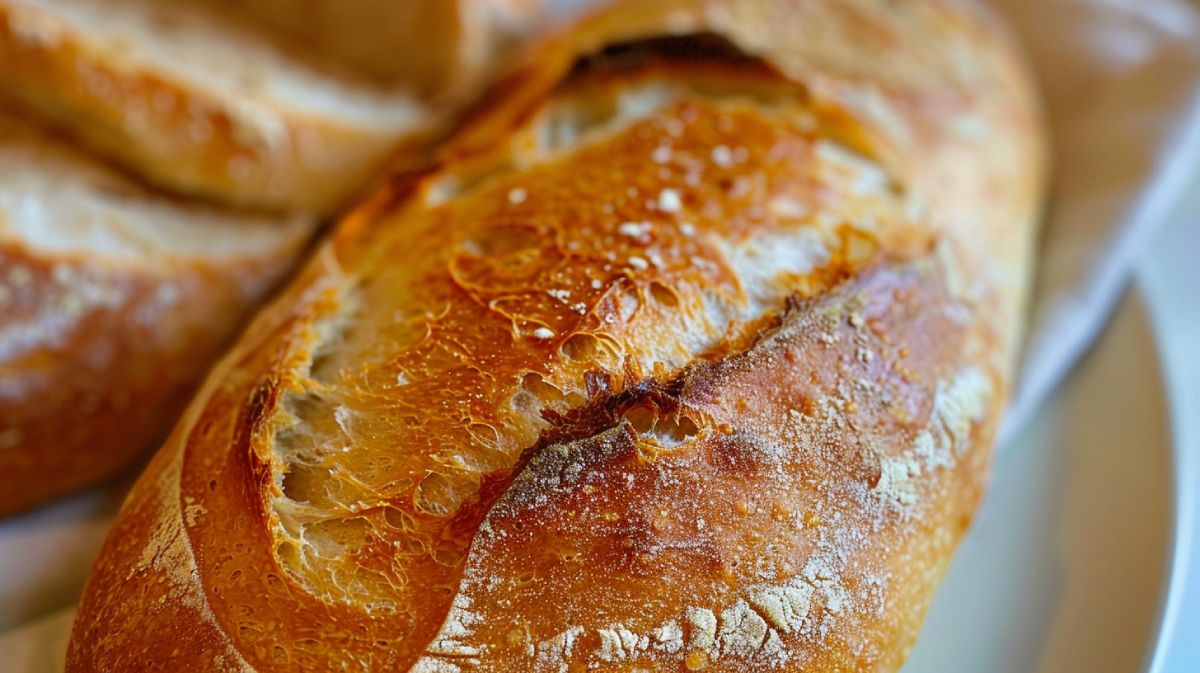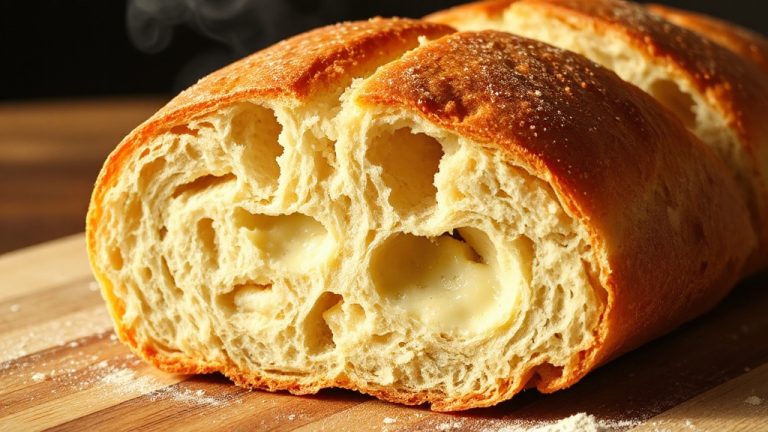How to Make Sourdough Bread Less Sour: The Balanced Loaf
To make your sourdough bread less sour, start by using all-purpose flour, which gives a milder flavor. You can also shorten fermentation time by doubling your starter amount, as this will reduce the production of acetic acid.
Maintain a healthy starter with regular feedings to balance your yeast and bacteria. When baking, try using higher temperatures and introduce steam to create a crust that masks tanginess.
Adding sweet ingredients, like honey or sugar, can also balance the acidity. Each tweak you make can enhance the flavor, and there’s even more to explore to perfect your loaf.
Key Takeaways
- Use all-purpose flour instead of whole grain to achieve a milder flavor profile in your sourdough bread.
- Shorten the fermentation time by doubling the amount of sourdough starter used in the recipe.
- Incorporate sugar or honey into the dough to balance acidity and promote faster fermentation.
- Maintain a drier sourdough starter, as it tends to produce less sourness than a wetter starter.
The Sourdough Sourness Concept
Sourdough’s unique sourness stems from a delicate balance of lactic and acetic acids, creating its distinctive flavor profile.
Lactic acid provides a mild tang when you bake sourdough, while acetic acid introduces a sharper, more pronounced sourness. This interplay is influenced by fermentation time; longer fermentations produce more acetic acid, leading to a tangier loaf, whereas shorter fermentations help tone down the sourness.
Temperature plays a significant role, too. Warmer temperatures can accelerate fermentation, ramping up acidity levels and enhancing that sour flavor.
The type of flour you choose also impacts the sourness. Whole grain flours typically yield bread with a bolder tang, thanks to their higher acetic acid production compared to all-purpose or plain flours.
Understanding the relationship between wild yeast and lactic acid bacteria (LAB) during fermentation is also essential. Optimizing their interaction allows you to customize the flavor profiles of your sourdough.
Techniques to Reduce Sourness
Consider adjusting your ingredients and fermentation techniques strategically to achieve a milder flavor in your sourdough bread.
Start by using all-purpose or plain flour instead of whole grains. Whole grains often yield tangier bread due to their higher acetic acid production. You can also shorten the fermentation time by doubling the amount of your sourdough starter, which helps develop a less sour flavor profile.
Another effective technique is to adjust your starter’s hydration level. Using a drier starter tends to produce less sourness compared to a wetter one. Additionally, incorporating sugar or honey into your dough can balance the acidity and speed up fermentation, resulting in that desired less sour taste.
Don’t forget the importance of feeding your starter regularly. Ideally, feed it twice daily at room temperature to maintain a healthy yeast population and lactic acid bacteria balance.
This way, you can prevent your starter from becoming overly sour and keep your bread’s flavor delightful. By implementing these techniques, you’ll be well on your way to creating delicious sourdough bread with a milder flavor.
Maintaining a Healthy Starter
Maintaining a healthy sourdough starter is key to achieving that perfect balance of flavor, ensuring your bread isn’t overly sour while still rising beautifully. To keep your starter active, feed it twice daily at room temperature. This regular feeding helps balance yeast and lactic acid bacteria (LAB), promoting a less sour flavor.
Here’s a quick reference table to guide you:
| Feeding Ratio | Flour Type | Result |
|---|---|---|
| 1:1:1 | All-purpose flour | Neutral flavor |
| 1:2:2 | Whole wheat flour | Slightly sour, more complex |
| 1:4:4 | Whole rye flour | Milder sourness |
| 1:2:2 | Bread flour | Chewy texture |
| 1:1:1 | Organic flour | Enhanced flavor complexity |
A healthy starter should double in size within 6-8 hours after feeding. If you see hooch forming, pour it off and add fresh flour and water. Monitor starter aromas; unpleasant smells may indicate an unhealthy mix, requiring more consistent feedings. Following the advice of experts like Debra Wink can also guide you toward maintaining that perfect dough balance.
Baking Techniques for Milder Flavor

When you’re ready to bake, consider using higher temperatures to create a crust that can effectively mask the sourness in your sourdough loaf. This method enhances crust development, forming a barrier that balances the flavor.
To further improve results, introduce steam in your oven; using a Dutch oven can help with even heat distribution, promoting that desirable crust.
Pay close attention to your dough consistency. Over-proofing can lead to increased sourness, so aim for that perfect balance during the proofing stage.
Extending your oven’s preheating time also plays an essential role; a longer preheating period can enhance flavor balance and reduce sourness in the final loaf.
As you bake, adjust the baking time based on your dough’s appearance and internal temperature. Underbaking can accentuate the sour flavor, so make sure you find the sweet spot where the loaf is perfectly baked through.
By mastering these baking techniques, you’ll take control over the flavor profile of your sourdough, resulting in a delightful bread that’s less tangy and more enjoyable.
Happy baking!
Flavor Enhancements and Additives
Enhancing the flavor of your sourdough bread can be achieved by incorporating various sweet ingredients and spices that not only balance the acidity but also elevate the overall taste experience. By carefully selecting these additives, you can divert attention from the sour flavor and create a more enjoyable loaf.
Here are three effective flavor enhancements to take into account:
- Sweet Ingredients: Adding honey, sugar, or fruit purees like applesauce or mashed bananas can greatly reduce the perception of sourness. These sweet elements not only balance the acid but also add moisture.
- Herbs and Spices: Incorporate herbs like rosemary or spices such as garlic powder to mask the sour notes. These additions create a complex flavor profile that enhances your bread.
- Cheese and Nuts: Mixing in cheese or nuts offers both flavor contrast and texture. The richness of cheese and the crunch of nuts can distract from the sourness while adding depth.
Experimenting with rye flour and various seeds, such as sunflower or sesame, can also enrich your loaf with additional flavors and nutrition, making your sourdough a delightful experience.
Frequently Asked Questions
Why Is My Sourdough Bread Too Sour?
Your sourdough bread might be too sour due to long fermentation times, unbalanced starter feeding, or using whole grain flours. Warmer temperatures can also accelerate acidity, resulting in that overly sharp flavor you’re experiencing.
How to Make Sourdough Bread No Sour?
Want to enjoy sourdough without the tang? Use all-purpose flour, double your starter, and keep the fermentation temperature between 70°F and 76°F. Adding a touch of sugar can also balance out the flavors beautifully!
How do you make a sourdough starter less sour?
To make your sourdough starter less sour, try using all-purpose flour, increase feedings to two or three times daily, adjust hydration levels, and consider adding a bit of sugar or honey to balance acidity.
How Do You Soften Sour Bread?
Ever find yourself battling hard, sour bread? You can soften it by wrapping it in a damp towel and heating it low, or try microwaving with water. These methods restore moisture and improve texture deliciously!
Transforming Bold Flavor into a Milder Delight
So, you want to make your sourdough less sour? Isn’t it ironic that the very essence of sourdough hinges on its tangy flavor?
Yet, with a few simple tweaks—like adjusting your fermentation time or feeding your starter more often—you can transform that bold bite into a milder delight.
Embrace the paradox: you can enjoy the tradition of sourdough while savoring a gentler taste.
After all, who said you can’t have your bread and eat it too?







